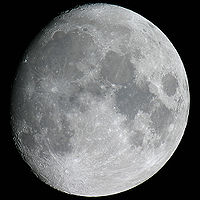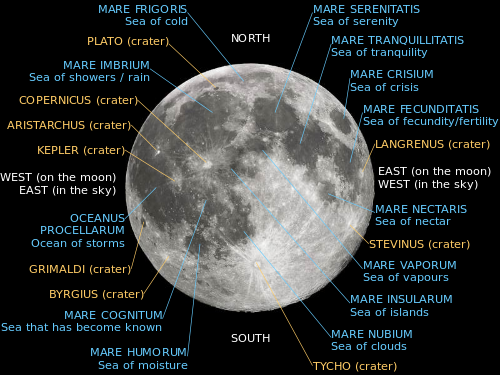- Observing the Moon
-
The Moon is Earth's largest natural satellite and the nearest major celestial object. Observing the Moon can be accomplished by using a variety of instruments ranging from the naked eye to large telescopes. For most people, the Moon is the only celestial object upon which surface features can be discerned with the naked eye (some people with good eyesight can see large sunspots on the surface of the Sun using handheld solar filters).
Contents
Optimal viewing times
Shadows provide a sense of depth.
Contrary to popular belief, the Moon should ideally not be viewed at its full phase. During a full moon, rays of sunlight are hitting the visible portion of the moon perpendicular to the surface. As a result there is much less surface detail visible during a full moon than during other phases (such as the quarter and crescent phases) when sunlight hits the Moon at a much shallower angle. In addition, the brightness of a full moon as compared to a phase where a smaller percentage of the surface is illuminated tends to wash out substantial amounts of detail and can actually leave an afterimage on an observer's eye that can persist for several minutes. First quarter (six to nine days past new moon) is generally considered the best time to observe the Moon for backyard stargazers. It is true that if one views the Moon during this time, a smaller percentage of the surface will be seen at a time, however the detail will be vastly more impressive. Shadows and detail are most pronounced along the "terminator", the dividing line between the illuminated (day side) and dark (night side) of the Moon.
Suggested viewing tools
Naked eye
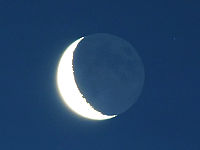 Earthshine reflecting off the Moon. The bright region at left is directly illuminated by the Sun, while the rest of the Moon is faintly illuminated by light reflected off the Earth.
Earthshine reflecting off the Moon. The bright region at left is directly illuminated by the Sun, while the rest of the Moon is faintly illuminated by light reflected off the Earth.
Generally, the Moon can be viewed even with the naked eye, however it may be more enjoyable with optical instruments. The primary lunar surface features detectable to the naked eye are the lunar maria or "seas", large basaltic plains which form the familiar "Man in the Moon" and other figures seen by many people who take a glance at a full moon. The maria cover about 35% of the surface. The contrast between the less reflective dark gray maria and the more reflective gray/white lunar highlands is easily visible without optical aid. Under good viewing conditions, those with keen eyesight may also be able to see some of the following features:
- Bright region around Copernicus
- Mare Nectaris
- Mare Humorum
- Bright region around Kepler
- Gassendi region
- Plinius region
- Mare Vaporum
- Lubiniesky region
- Sinus Medii
- Faintly shaded area near Sacrobosco
- Dark spot at foot of Mons Huygens
- Riphean Mountains
Another interesting phenomenon visible with the naked eye is Earthshine. Best visible shortly before or after new moon (during the waning and waxing crescent phases respectively), Earthshine is the faint glow of the non-illuminated (night) side of the Moon caused by sunlight reflecting off the surface of Earth (which would appear nearly full to an observer situated on the Moon at this time) and onto the night side of the Moon. By the time the Moon reaches first quarter however, the sunlight illuminated portion of the Moon becomes far too bright for Earthshine to be seen with the naked eye however it can still be observed telescopically.
Binoculars
Binoculars are commonly used by those just beginning to observe the Moon and many experienced amateur astronomers prefer the view in binoculars to a telescopic view due to the larger field of view. Their high level of portability makes them the simplest device used to see more detail on the surface beyond naked eye observing.
The primary disadvantage of binoculars is that they cannot be held very steady unless one utilizes a commercial or homemade binocular tripod. The recent introduction of image-stabilized binoculars has changed this to some extent; however, cost is still an issue.
Telescopes
To some it may be far more desirable to utilize a telescope in which case far more options for observing the Moon exist. Even a small, well-made telescope will show the observer far more than is visible with the naked eye or small binoculars. As the aperture of the telescope mirror (in the case of a reflecting telescope) or lens (in the case of a refracting telescope) increases, smaller and smaller features will begin to appear. With large amateur telescopes, features as small as 0.6 miles (1 km) in diameter can be observed depending on atmospheric conditions.
Most astronomers use different kinds of filters in order to bring out the contrast of certain surface features. Simple neutral density filters are also common as they can cut down the amount of light reaching the eye by 60–95%, something that is helpful especially when observing a full or gibbous moon so the surface does not appear as washed out.
Lunar occultations
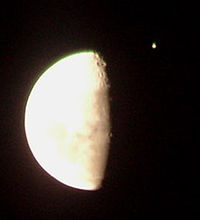 Jupiter (the bright object in the upper right) a few minutes before being occulted by the Moon on June 7, 2005
Jupiter (the bright object in the upper right) a few minutes before being occulted by the Moon on June 7, 2005
An occultation is an astronomical event where a celestial object appears completely hidden by another, closer body (with a greater angular diameter) due to the passage of the closer object directly between the more distant object and the observer. Due to the large apparent size of the Moon, lunar occultations are quite common and when a bright celestial object is involved, the result is an event that can be easily observed using the naked eye. The Moon almost constantly occults faint stars as it orbits the Earth but because even a young Moon appears immensely brighter than these stars, these events are difficult to observe using amateur telescopes. However, the Moon does frequently occult brighter stars and even planets due to its close proximity to the ecliptic. Four first magnitude stars, Regulus, Spica, Antares, and Aldebaran, are sufficiently close to the ecliptic that they may be occulted by the Moon. In addition, two star clusters visible to the naked eye, the Beehive Cluster and the Pleiades, are often occulted. Depending on one's location on the Earth, there are usually several occultations involving naked eye objects every year and many more that can be observed using binoculars or a telescope.
Accurate timings (accuracy within a few tenths of a second) of lunar occultations are scientifically useful in fields such as lunar topography, astrometry, and binary star studies. These timings are regularly obtained by amateur astronomers using readily available instruments to observe the Moon.
Transient Lunar Phenomena
A transient lunar phenomenon (TLP) or "Lunar Transient Phenomena" (LTP), refers to short-lived lights, colors, or changes in appearance of the lunar surface.
Claims of these phenomena go back at least 1,000 years, with some having been observed independently by multiple witnesses or reputable scientists. Nevertheless, the majority of transient lunar phenomena reports are irreproducible and do not possess adequate control experiments that could be used to distinguish among alternative hypotheses. Few reports concerning these phenomena are ever published in peer reviewed scientific journals, and rightfully or wrongfully, the lunar scientific community rarely discusses these observations.
Most lunar scientists will acknowledge that transient events such as outgassing and impact cratering do occur over geologic time: the controversy lies in the frequency of such events.
A number of astronomical societies around the world have implemented their own TLP watch programs and TLP alert networks.
Features with reported TLP Associations
Blinking devices
A number of observers employ different coloured filters to determine coloured transient events on the Moon. By quickly alternating filters of opposing colours in the telescopic light path, faintly coloured areas on the Moon can stand out more by appearing to flicker on and off. A red area will appear brighter when viewed through a red filter and darker when seen through a blue filter. It is possible to alternate the filters manually however, this requires a certain dexterity of the hand and good coordination. A purpose built filter wheel is much more viable alternative, and this can be motorised, so the observer can devote all of their concentration to what is going on through the eyepiece. There are, however a number of features on the Moon that will appear to blink naturally, among the being the southwestern part of Fracastorius (crater), and a section of the wastern wall of Plato (crater). A special filter wheel called a "crater extinction device" is capable of measuring the brightness of an individual lunar feature to be measured according to the point where it ceases to be visible.
Banded lunar craters
Observation of the crescent Moon
Measurement of lunar features using their shadows
Other items of interest
Because the Moon is so bright, it is especially interesting to see objects "superimposed" on it. One particular point of interest is an ISS (International Space Station) transit. These can be seen every so often and several services exist that will contact you with expected times of transit.
See also
- List of lunar craters
- Moon
- Observational astronomy
- Planetshine
- Transient lunar phenomena
References
- Observing the Moon: The Modern Astronomer's Guide – PDF format
- Alexander Vandenbohede (2005). "Observing the lunar libration zones". http://users.pandora.be/lunar/jpeg/libratieboek.pdf.
- "The Current Value of Lunar Occultation Observations". International Occultation Timing Association (IOTA). http://lunar-occultations.com/iota/occvalue.htm.
- Grego, Peter (2005), The Moon and how to Observe it, Springer, ISBN 1-85233-748-6
- Levy, David (2001), David Levy's Gude to the Night Sky, Cambridge University Press, ISBN 0-521-79753-5
The Moon Physical features 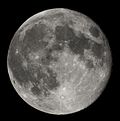
Orbit Lunar surface - Selenography
- Near side
- Far side
- Lunar mare
- (List)
- Craters
- (List)
- Mountains
- Valleys
- South Pole – Aitken basin
- Shackleton crater
- Water
- Soil
- Peak of eternal light
- Space weathering
- Transient lunar phenomenon
Lunar science - Geology
- (timescale)
- Giant impact hypothesis
- Moon rocks
- Lunar meteorites
- KREEP
- ALSEP
- Lunar laser ranging
- Late Heavy Bombardment
- Observing the Moon
Exploration Other topics - See also Solar System
- Natural satellite
Categories:
Wikimedia Foundation. 2010.

